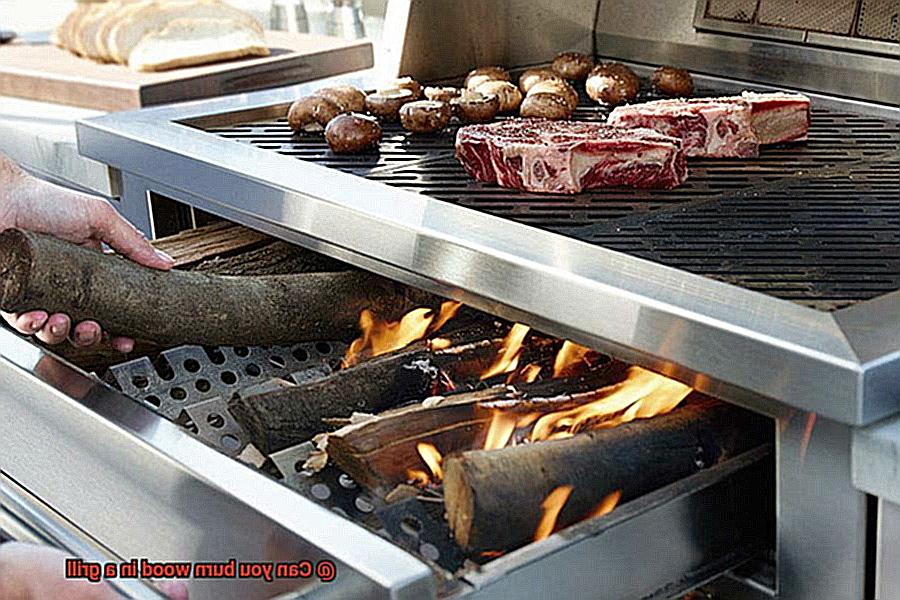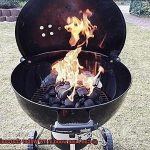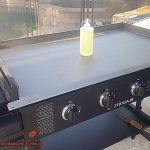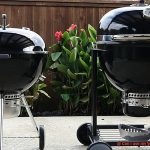Picture this – it’s a warm summer evening, and the tantalizing aroma of freshly grilled meat is wafting through the air. For true grill aficionados, cooking with propane or charcoal just doesn’t cut it. They crave the unmistakable smoky flavor that only comes from using real wood. But can you burn wood in a grill?
The answer is a resounding yes. In fact, wood-fired grilling has been around for centuries and was what our ancestors used to cook their meals before modern conveniences like gas and electric grills existed. However, there are a few things to keep in mind before you start throwing logs onto your grill.
Firstly, not all grills are created equal. While some are specifically designed for wood-fired grilling, others may not be able to handle the heat or large flames that come with burning wood. Secondly, using wood as a fuel source requires finesse – you need to know how to properly start a fire, maintain the temperature, and control the smoke.
But trust us when we say that the effort is worth it. Wood-fired grilling produces an unparalleled flavor profile that’s hard to replicate with any other method. So if you’re a fan of bold, smoky flavors, it’s time to invest in a grill that can handle burning wood. Get ready to take your grilling game up several notches.
Contents
What Grills Can Use Wood as a Fuel Source?
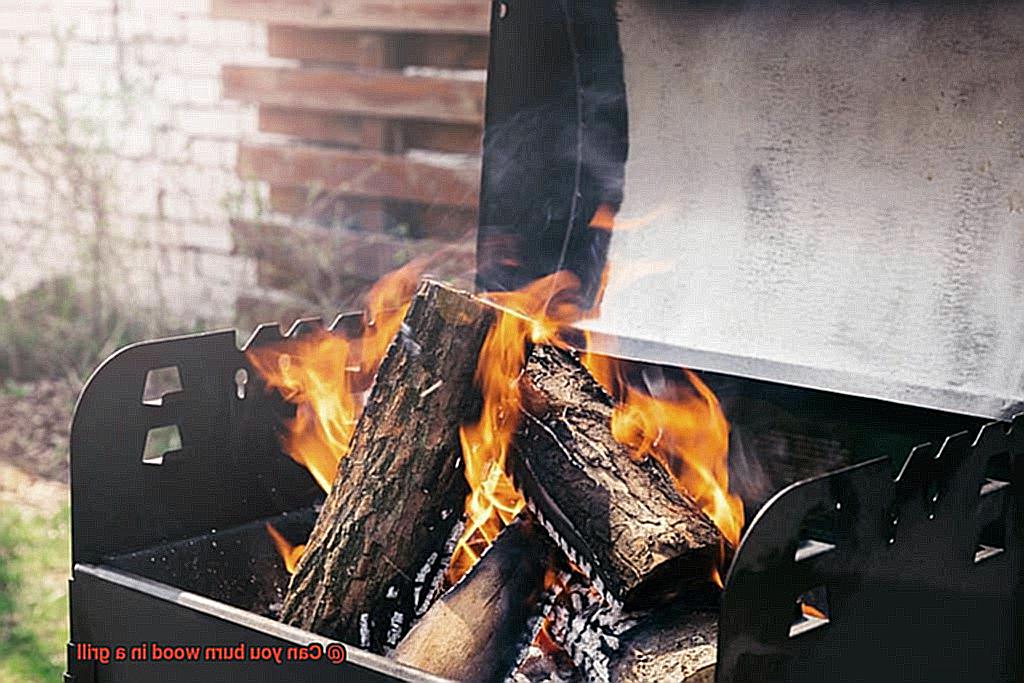
Grilling with wood is a popular way to achieve that signature taste, but not all grills are created equal. So, what grills can use wood as a fuel source? Let’s explore.
Charcoal grills are a versatile option for those who want to use wood as a fuel source. These grills can handle both charcoal and wood, giving you the flexibility to experiment with different flavors. However, not all charcoal is created equal, and some brands are better suited for burning wood than others. Choose a high-quality brand that can handle the intense heat and smoke that comes with using wood.
If you’re new to grilling with wood, then a pellet grill might be the perfect option for you. These grills use compressed sawdust pellets as a fuel source and have an electronic control panel that allows you to set the temperature and cook time with precision. Pellet grills are easy to use, making them a great option for beginners who want that authentic smoky flavor.
For those who prefer a more traditional smoking experience, an offset smoker is the way to go. These smokers use wood logs or chunks as the primary fuel source, giving you that classic smoky flavor. Offset smokers have a firebox located next to the cooking chamber, which allows you to control the temperature and smoke level by adjusting the airflow and adding more wood as needed.
It’s worth noting that gas grills are generally not designed to burn wood as a fuel source. While some models may have a smoker box or flavorizer bars that allow you to add wood chips for extra flavor, this is not the same as using wood as the primary fuel source. To achieve that distinctive smoky flavor, invest in a grill that is specifically designed for using wood as a fuel source.
Different Types of Wood for Grilling
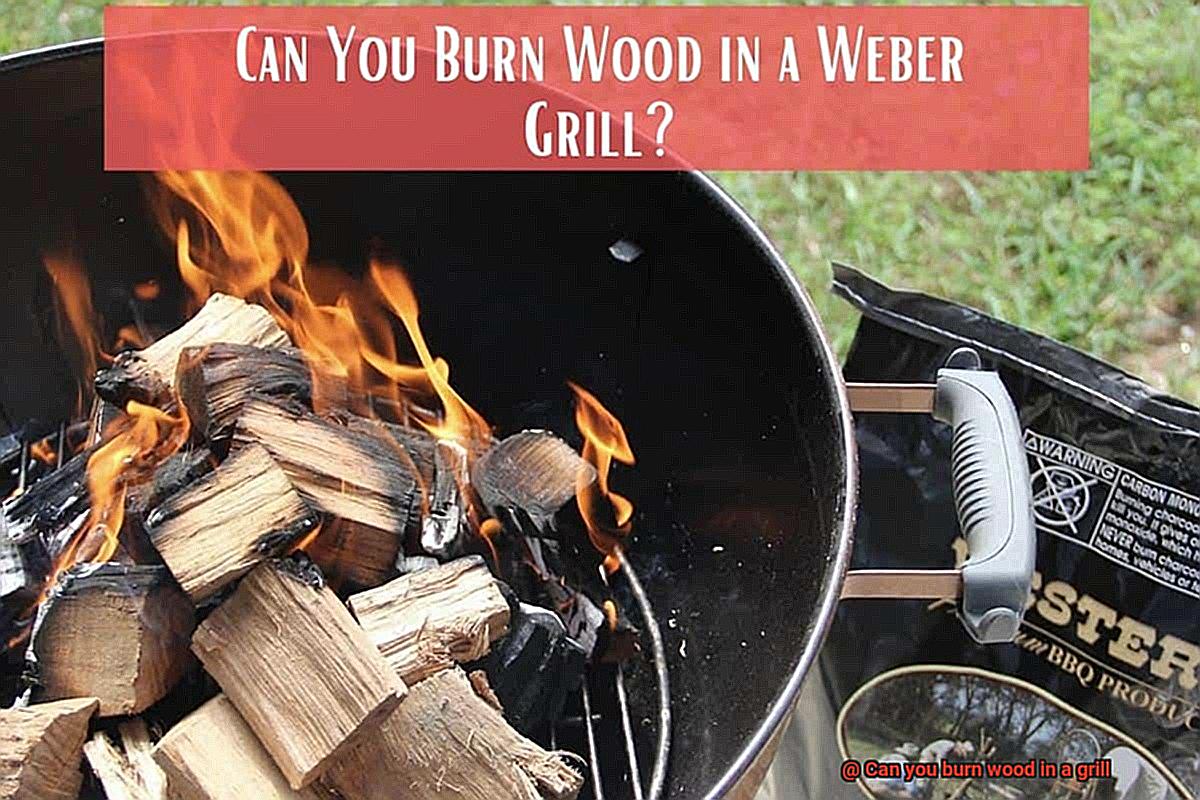
Grilling is an age-old tradition that has evolved over time. From charcoal to propane, there are many fuel sources that can be used for grilling. However, using wood as a fuel source remains a favorite among many grillers. There are many different types of wood for grilling, each with its own unique flavor that can enhance the taste of your food. Let’s explore the different types of wood and how they affect the flavor of your food.
Hickory
Hickory wood is one of the most popular woods for grilling because it gives a strong, smoky flavor to the food. It is particularly good for smoking ribs, brisket, and pork. The intense flavor that hickory adds to your food can be overpowering if not used in moderation. So, it’s best to use it sparingly to avoid overwhelming your dish.
Mesquite
Mesquite is another popular wood for grilling. It has a strong, earthy flavor that goes well with beef and poultry. Mesquite burns hot and fast, making it perfect for searing steaks or chops.
Oak
Oak is a versatile wood that can be used for grilling a variety of foods. It gives a mild, smoky flavor that is not overpowering. Oak is a good choice if you want to add a subtle smokiness to your food without overwhelming it.
Apple
Apple wood gives a sweet, fruity flavor to your food, making it ideal for grilling chicken and pork. Apple wood burns slowly and evenly, making it perfect for smoking.
Cherry
Cherry wood gives a mild, sweet flavor to your food that complements poultry, pork, and fish. Cherry wood burns slowly and at a low temperature, making it perfect for smoking.
Alder
Alder wood is a popular choice for grilling fish because it gives a light, smoky flavor that doesn’t overpower the delicate taste of the fish. Alder wood burns slowly at a low temperature, making it ideal for smoking.
Maple
Maple wood gives a sweet, delicate flavor to your food, making it particularly good for grilling salmon and other seafood. Maple wood burns slowly and evenly, making it ideal for smoking.
When selecting the type of wood to use for grilling, it’s important to match it with the food you’ll be cooking. The level of smokiness you want in your dish should also be considered. Some woods, like hickory and mesquite, are very strong and can easily overpower the taste of your food if used in large quantities. On the other hand, fruit woods like apple and cherry are more subtle and can be used in larger quantities without overwhelming the dish.
The Benefits of Using Wood as a Fuel Source
When it comes to grilling, there’s nothing quite like the smoky flavor that wood can provide. As an expert in the benefits of using wood as a fuel source, I can attest that it is a great option for any self-proclaimed grill master. Let’s explore the many advantages of using wood as your go-to fuel source.
Firstly, let’s talk about cost. Wood is an affordable option for those who love to grill but don’t want to break the bank on fuel costs. It’s a readily available resource in many areas and can often be obtained for free or at a low cost. Plus, collecting your own wood from nearby forests or parks can be a fun and eco-friendly activity with friends and family.
Speaking of eco-friendliness, using wood as a fuel source is also a sustainable option. It’s a renewable resource that produces fewer emissions when burned compared to fossil fuels like propane or natural gas. By using wood, you can reduce your carbon footprint while still indulging in your passion for grilling.
But let’s not forget about the most enticing benefit of using wood – its unique flavor. The smoke from burning wood infuses the food with a delicious smoky taste that cannot be replicated with other fuel sources. Each type of wood has its own distinct personality that can enhance the taste of your dish. Whether you prefer the strong smoky flavor of hickory or the sweet and fruity aroma of apple, there’s a type of wood that will take your grilled dishes to new heights.
How to Monitor the Temperature While Grilling with Wood
Grilling with wood can add a delicious smoky flavor to your food, but it requires careful attention to temperature control. Here are some tips to help you perfectly monitor the temperature while grilling with wood.
Choose the Right Thermometer
A reliable thermometer is essential for monitoring the temperature while grilling with wood. You can use either an analog or digital thermometer, but make sure it’s placed near the meat or food being cooked for the most accurate reading. Digital thermometers are more accurate than analog thermometers and can provide temperature readings in just a few seconds.
Understand Temperature Zones
Different parts of your grill may have different temperature zones. For example, if you’re using a charcoal grill, you may have a hot zone directly over the coals and a cooler zone on the other side of the grill. Understanding these zones can be useful for cooking different types of food at different temperatures or for keeping food warm while other items finish cooking.
Know Your Wood
Different types of wood can affect the temperature and flavor of your food. Hardwoods like oak and hickory burn hotter and longer, while fruitwoods like apple and cherry provide a milder smoke flavor. It’s important to do your research on the type of wood you want to use and how it will affect the flavor of your food.
Monitor Continuously
Keep an eye on the temperature throughout the cooking process. Adjusting the amount of wood or adding more charcoal can help regulate the temperature as needed. Remember, patience is key when grilling with wood – it may take longer for your food to cook, but the delicious smoky flavor is well worth the wait.
Observe Smoke Color
In addition to using a thermometer, you can also monitor the temperature by observing the color of smoke coming from your grill. Thick, black smoke means that the grill is too hot and needs to be adjusted. On the other hand, thin, blue smoke means that your cooking temperatures are just right.
Maintenance Requirements When Using Wood as a Fuel Source
If so, it’s important to understand the maintenance requirements that come along with using wood as a fuel source. By following a few key steps, you can ensure a safe and efficient grilling experience that produces mouth-watering results every time.
First and foremost, cleaning out the ash from your grill after each use is crucial to maintaining optimal airflow and consistent temperatures during grilling. A buildup of ash can also be a fire hazard. To avoid any danger, wait until the ash has cooled down before removing it from the grill.
In addition to cleaning out ash, regularly checking and cleaning your grill’s chimney or vents is essential. Burning wood can lead to creosote buildup, which can cause a fire hazard if not properly addressed. To prevent this issue, aim to clean the chimney or vents at least once a year or as needed.
Moisture buildup in your wood can also create issues during grilling, such as excess smoke and an unpleasant taste in your food. To prevent this, make sure to store your wood in a dry, ventilated area. This simple step will ensure that your wood is ready to use whenever you’re ready to grill.
Lastly, consider using a cover for your grill when not in use. This will protect it from weather elements such as rain, snow, and extreme temperatures that can cause damage and reduce its lifespan.
Tips and Tricks for Grilling with Wood
Grilling with wood is a great way to add an extra layer of flavor to your food, but it does require some finesse. To help you get the most out of your wood-grilling experience, we’ve compiled some tips and tricks:
Choose the right type of wood
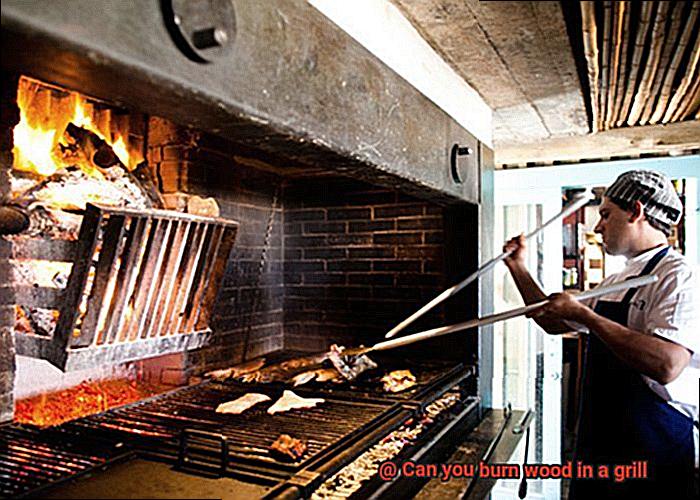
Different types of wood will impart different flavors to your food. Hickory is known for its strong, smoky flavor, while fruitwoods like apple and cherry provide a sweeter, subtler taste. Make sure to choose a wood that complements the type of meat or veggies you’ll be grilling.
Soak the wood
If you’re using wood chips or chunks, soak them in water for at least 30 minutes before grilling. This will help prevent them from burning too quickly and creating an acrid flavor. Instead, the soaked wood will smoke and add delicious flavor to your food.
Use indirect heat
To avoid burning your food, it’s best to use indirect heat when grilling with wood. This means placing the coals or burners on one side of the grill and the food on the other side. This way, the food can cook more slowly and absorb more of the smoky flavor from the wood.
Keep an eye on the temperature
Wood burns hotter than charcoal or gas, so it’s important to monitor the temperature gauge and adjust accordingly. You may need to open or close the vents to regulate the heat and prevent flare-ups.
Don’t overdo it
While the flavor from wood smoke can be amazing, too much smoke can make your food taste bitter and overpowering. So be careful not to overdo it with the wood – a little goes a long way.
Common Mistakes to Avoid When Grilling with Wood
Grilling with wood can add a whole new dimension of flavor to your dishes, but it’s important to know what mistakes to avoid. As an expert in this field, let me share some common pitfalls and how to steer clear of them.
Firstly, using too much wood can be a recipe for disaster. It’s easy to get carried away and add too many wood chips or chunks, but this can result in an overpowering smoky flavor that masks the taste of your food. Remember, less is more. Use no more than a handful of wood chips or a couple of small chunks at a time to achieve the perfect balance of flavor.
Secondly, not soaking the wood is another mistake that can ruin your dish. If you’re using wood chips, take the time to soak them in water for at least 30 minutes before adding them to your grill. Soaking the wood helps prevent it from burning too quickly and producing acrid smoke that can ruin the taste of your food.
Thirdly, not preheating the grill is another common error. Before adding your wood chips or chunks, make sure your grill is preheated to the proper temperature. This ensures that the wood will smolder and produce smoke instead of burning up too quickly.
Lastly, placing the wood directly on the coals is a mistake that many people make. If you’re using wood chunks, make sure to place them on top of the coals rather than directly on them. Placing the wood on the coals can cause it to catch fire and burn up quickly, resulting in less smoke and flavor for your food.
5oz3rJrESbY” >
Conclusion
To sum it up, grilling with wood is a time-honored tradition that can elevate your meals to new heights of flavor. While not all grills are created equal when it comes to burning wood, there are plenty of options available that can handle the heat and smoke that come with using this fuel source. Different types of wood also impart different flavors, so it’s important to choose the right one for your dish.
When it comes to grilling with wood, temperature control is key to achieving the perfect smoky taste without overcooking or undercooking your food. Regular maintenance of your grill is also essential for optimal airflow and preventing any fire hazards.
While there are some common mistakes to avoid, such as using too much wood or not soaking it properly, following some simple tips and tricks can help you achieve mouth-watering results every time. With patience and skill, you can take your grilling game up several notches by using wood as a fuel source. So why not explore the world of wood-fired grilling?

